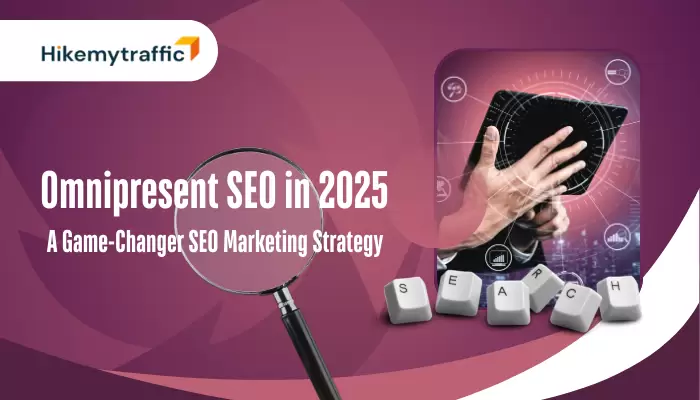SEO Ranking Factors in 2025
Search Engine Optimization (SEO) is the backbone of online visibility. Whether you're running a blog, an eCommerce website, or a corporate portal, understanding the essential SEO ranking factors can significantly impact your digital success. Google, the most popular search engine, considers hundreds of ranking factors to determine a website's position in search results.

In this comprehensive guide, we will explore the most important SEO ranking factors, including On-page SEO ranking factors, off-page SEO ranking factors, technical SEO ranking factors, local SEO ranking factors, and Google SEO ranking factors that influence your website’s rankings.
What Are SEO Ranking Factors?
SEO ranking factors are the criteria search engines use to evaluate and rank web pages in search results. These factors influence how search engines determine the relevance and quality of a webpage for a given search query. While Google considers hundreds of ranking signals, some factors hold more weight than others.Categories of SEO Ranking Factors:
On-page SEO ranking factors
on-page SEO ranking factors refer to elements directly within a webpage that influence rankings. These include content, keywords, metadata, internal linking, and other aspects that improve user experience and search engine understanding.
Keywords in URL
A well-structured URL that includes the target keyword helps search engines and users understand the content of a page. For example, a URL like www.hikemytraffic.com/best-running-shoes is more effective than www.hikemytraffic.com/page123.Keywords in Meta Description
The meta description is a short summary of a page’s content that appears in search results. Including keywords naturally within the description can increase the likelihood of users clicking on your page.Heading Hierarchy (H1, H2, H3)
Headings help organize content for both users and search engines. The H1 tag should be reserved for the main title, while H2 and H3 tags can be used for subheadings to improve readability and SEO.Schema Markup
Schema markup is a type of structured data that helps search engines understand content better. It allows rich results such as star ratings, event dates, and product prices to appear in search results, increasing visibility.In-Depth Content
Comprehensive content that thoroughly answers user questions ranks higher than brief or superficial articles. Long-form content (1,500+ words) often ranks better because it provides more information.Internal Linking
Linking to other relevant pages on your website helps users navigate more easily and keeps them engaged longer. Internal links also distribute ranking power across your site.Keyword Density
Using keywords naturally throughout the content without overstuffing is important. Google can penalize keyword stuffing, so focus on readability and relevance.Image Optimization
Optimized images load faster, improving page speed. Adding descriptive alt text helps search engines understand the content of the image, which also improves accessibility.User Engagement
Metrics such as time on site, number of pages viewed, and interactions (likes, shares, comments) indicate valuable content. Engaged users signal to Google that your site is useful.Content Readability
Content that is easy to read and understand keeps users on the page longer. Avoid overly complex language and use short paragraphs, bullet points, and visuals.Off-page SEO ranking factors
Off-page SEO involves external factors that impact rankings, primarily through backlinks and social signals.
Backlink Authority
Backlinks from high-authority websites improve rankings significantly. A strong backlink profile includes links from trusted sources like government sites, universities, and reputable businesses.Brand Mentions
Google recognizes brand mentions (even without backlinks) as a signal of credibility.Guest Blogging
Writing blog posts for other reputable websites allows you to gain backlinks and drive traffic.Social Signals
Although social media activity isn’t a direct ranking factor, likes, shares, and comments increase visibility and engagement, indirectly benefiting SEO.Technical SEO Ranking Factors
Technical SEO focuses on backend aspects that enhance a website’s performance, crawlability, and security.Website Speed and Performance
Website speed refers to how quickly a webpage loads. A fast-loading site improves user experience, reduces bounce rates, and positively impacts SEO rankings. Performance can be optimized by compressing images, minimizing HTTP requests, leveraging browser caching, and using a Content Delivery Network (CDN).Mobile-Friendliness
Mobile-friendliness ensures that a website is optimized for smartphones and tablets. A responsive design, fast-loading pages, and easy navigation enhance user experience and improve rankings on search engines like Google, which prioritize mobile-first indexing.SSL Security (HTTPS)
SSL (Secure Sockets Layer) encrypts data between a user’s browser and a website, ensuring security and privacy. Websites with HTTPS (rather than HTTP) protect sensitive information, build trust, and rank higher in search results, as Google favors secure websites.XML Sitemap
An XML sitemap is a file that lists all important pages of a website, helping search engines crawl and index content efficiently. It improves SEO by ensuring search engines discover new or updated pages faster.Structured Data (Schema Markup)
Structured data is a type of code (Schema.org markup) added to a website to help search engines understand its content. It enhances search results with rich snippets, such as star ratings, FAQs, and product details, improving visibility and click-through rates.Canonical Tags
A canonical tag (rel="canonical") tells search engines which version of a page is the preferred one when duplicate or similar content exists. It prevents duplicate content issues and ensures proper indexing, helping to consolidate SEO value.Content Factors
Here are some content factors, that are also responsible for SEO ranking factors explained in detail:
Rich Content
Content that includes images, videos, infographics, and other multimedia elements tends to perform better in search rankings. This is because visually appealing content enhances user engagement, making the material easier to understand and more enjoyable to consume. Search engines like Google consider user engagement metrics such as time spent on a page and bounce rate, and rich content helps improve these metrics.
Additionally, images and videos can rank separately in Google’s image and video search results, providing extra visibility for a webpage. Optimizing images with alt text and using proper video metadata further enhances search engine optimization (SEO).
Unique Content
Search engines penalize duplicate content because copied material does not add value to users. Unique, original content is essential for improving rankings and gaining authority in a specific niche. When content is copied from another source, Google either ignores it or demotes the ranking of the page containing the duplicated text.Original content ensures that the information provided is fresh, valuable, and different from what is already available on the internet. Unique insights, research, and case studies are particularly effective in distinguishing content from competitors.
In-Depth Content
Search engines prioritize content that thoroughly covers a topic instead of shallow, surface-level material. In-depth content provides detailed explanations, examples, statistics, and research findings, making it more valuable to readers. Google’s algorithms, including BERT and RankBrain, are designed to understand user intent and reward content that satisfies search queries comprehensively.
Long-form content, often exceeding 1,500 words, tends to perform well because it answers multiple related questions in a single post, reducing the need for users to search elsewhere. Adding internal links to related content also improves a page’s authority and ranking.
Long-Tail Keywords
Long-tail keywords are specific phrases that target niche searches, making it easier to rank for them compared to broad, highly competitive keywords. For example, instead of targeting the keyword "running shoes," targeting "best running shoes for flat feet" allows a website to reach a more specific audience. Long-tail keywords often have lower search volume but higher conversion rates because they align closely with user intent. Optimizing content for these phrases helps attract targeted traffic and improves the chances of ranking higher on search engines.Content for Featured Snippets
Featured snippets are special search results displayed at the top of Google’s search results, often providing quick answers to user queries. Structuring content specifically to appear in featured snippets can significantly increase visibility and drive more traffic. Common snippet formats include paragraph summaries, lists, tables, and step-by-step instructions.
To optimize for featured snippets, content should include concise answers to common questions, clear formatting, and relevant keywords in headings and subheadings. Google tends to pull answers directly from well-structured and authoritative content.
Use of Lists, Tables & Points
Organizing content into lists, tables, and bullet points makes it easier for readers to scan and absorb information quickly. Structured content improves readability, which in turn enhances user experience and engagement. Search engines recognize well-organized content as user-friendly and often prioritize it in rankings.For example, numbered lists are frequently used for step-by-step guides, and tables are useful for comparing data. The easier it is for users to find information within content, the more likely they are to stay on the page, reducing bounce rates and improving SEO.
User-Generated Content
User-generated content (UGC), such as customer reviews, forum discussions, and comments, helps keep a webpage dynamic and regularly updated. Fresh content signals to search engines that a site is active and relevant. Reviews also improve trustworthiness and influence purchasing decisions.
Forums and comment sections allow users to ask questions and provide insights, increasing engagement and session duration. Encouraging user participation through discussions, testimonials, and feedback can significantly enhance a website’s credibility and SEO performance.
Voice Search Content
As voice search usage grows with devices like Google Assistant, Siri, and Alexa, optimizing content for voice queries is essential. Voice searches are typically longer and more conversational than text-based searches. To optimize for voice search, content should include natural language, question-based phrases, and direct answers.
For example, instead of focusing only on "best restaurants in New York," a page optimized for voice search would include conversational queries like "What are the best restaurants to try in New York?" Structuring content in an FAQ format can also improve voice search rankings.
Video Content
Videos increase user engagement and help keep visitors on a website for longer periods. Search engines recognize this increased engagement as a positive ranking factor. Video content is highly shareable and can be distributed across multiple platforms, including YouTube, which is the second-largest search engine after Google. Including video transcripts, captions, and relevant keywords in video descriptions helps improve SEO. Google often displays video results in search rankings, making video content an effective way to enhance online visibility.Content Specificity
Highly focused, niche-specific content ranks better because it caters to a well-defined audience. Instead of covering broad topics, content should focus on detailed, specific aspects of a subject. For example, rather than writing about "digital marketing," a piece on "email marketing strategies for SaaS startups" is more likely to rank well because it targets a particular group of users.Specific content demonstrates expertise and relevance, increasing its chances of ranking higher for related queries. Additionally, niche content tends to attract more engaged and loyal readers, which benefits long-term SEO efforts.
User Experience Factors
User Experience (UX) plays a crucial role in SEO ranking factors within digital marketing. Search engines like Google prioritize websites that offer a smooth, engaging, and user-friendly experience. Here are some key UX factors that impact SEO rankings:
User Engagement
User engagement refers to how much time visitors spend interacting with your website. The longer they stay, the more Google considers your site valuable and relevant. High engagement usually means that users find your content useful, leading to better search rankings. Strategies to improve engagement include high-quality content, engaging visuals, and interactive features that keep users interested.Bounce Rate
Bounce rate is the percentage of users who leave your site quickly after visiting just one page. A high bounce rate signals to search engines that your content or user experience is lacking. This can be caused by slow page load times, irrelevant content, or poor design. Reducing bounce rate involves improving page speed, creating compelling content, and enhancing site navigation to keep users engaged.Click-Through Rate (CTR)
CTR measures how often users click on your site link when it appears in search results. A higher CTR indicates to Google that your page is relevant to user queries. To improve CTR, focus on writing compelling meta titles, clear descriptions, and using structured data to make your listing stand out. Engaging and curiosity-driven headlines also encourage more clicks.Mobile User Experience
With most users browsing on mobile devices, having a mobile-friendly website is essential. Google prioritizes mobile-first indexing, meaning that your site’s mobile version is what gets ranked. A responsive design, fast loading speeds, and touch-friendly navigation contribute to a good mobile user experience and better rankings.Clear Site Structure
A well-structured website helps both users and search engines navigate efficiently. A clear hierarchy with logical categories and internal links improves usability and indexing. Sites with a clear structure perform better because they make it easy for visitors to find information, reducing frustration and increasing engagement.Easy Navigation
Simple and intuitive navigation improves user satisfaction and keeps visitors on your site longer. Clear menus, search bars, and well-organized categories help users find what they need quickly. Poor navigation can lead to high bounce rates, as users will leave if they struggle to access information.Interactive Elements
Adding interactive features such as quizzes, polls, buttons, and comment sections makes a website more engaging. These elements encourage users to participate and spend more time on the site. Interactive content also boosts social sharing, increases retention, and enhances overall user experience.Clear Accessibility
A website should be accessible to all users, including those with disabilities. Features like alt text for images, keyboard navigation, and screen reader compatibility ensure inclusivity. Websites that prioritize accessibility not only improve user experience but also meet legal requirements and rank better in search engines.Content Readability
Easy-to-read content is essential for a good user experience. Short paragraphs, bullet points, and simple language improve readability. Avoiding complex jargon ensures that your content is understandable to a broader audience. Readable content leads to higher engagement, better retention, and improved rankings.User Feedback
Encouraging reviews, comments, and ratings helps build trust and credibility. Search engines recognize user-generated content as a sign of an active and valuable site. Positive feedback enhances reputation while responding to negative feedback shows responsiveness and improves brand trustworthiness.Local SEO Ranking Factors
Local SEO is crucial for businesses targeting geographic locations.
1. Google My Business (GMB) Optimization
Ensure accurate business details.Encourage customer reviews.2. NAP Consistency (Name, Address, Phone Number)
Consistent information across directories boosts local rankings.3. Local Citations
Listings in directories like Yelp, Bing Places, and Apple Maps improve local SEO.4. Customer Reviews and Ratings
Positive reviews influence rankings and trustworthiness.5. Location-Based Keywords
Include city and region-specific keywords in content and meta tags.Social or Trust Factors
Social and trust factors play a crucial role in determining a website's credibility and influence both user trust and search engine rankings. While search engines do not use social signals as a direct ranking factor, their indirect impact on SEO and brand perception is significant. Let’s dive into each factor in detail: 
1. Social Media Engagement
Social media engagement refers to the level of interaction users have with your content on platforms like Facebook, Twitter, LinkedIn, Instagram, and others. This includes actions like likes, shares, comments, and retweets.Although Google has stated that social media signals are not a direct ranking factor, increased engagement often leads to more visibility, organic traffic, and external links, all of which contribute to better search rankings.
2. Influencer Mentions
Influencer marketing is a powerful strategy for building trust and authority. When a well-known figure in an industry mentions or endorses a brand, it boosts credibility and encourages their followers to trust and engage with the brand.For example, if a digital marketing expert shares an article about email marketing services like SMTPget, their followers may check out the brand, engage with its content, and even convert it into customers.
3. Social Shares and Likes
While Google does not count social shares and likes as direct ranking factors, they influence SEO in multiple indirect ways: Increased Content Visibility – Content that receives a high number of shares gets more exposure, leading to a higher likelihood of gaining backlinks from other websites.For example, if an article about email marketing best practices goes viral on LinkedIn, it can attract thousands of visits, leading to backlinks and mentions on other websites, ultimately boosting SEO performance.
4. Trust Signals Like Reviews
Online reviews play a critical role in shaping consumer trust and can directly impact local SEO rankings, especially in Google My Business (GMB) listings. Google and other search engines consider reviews as trust signals. Websites or businesses with a higher number of positive reviews tend to rank better in local searches.For example, if a company like SMTPget has many 5-star reviews on platforms like Google, Trustpilot, or G2, potential customers are more likely to trust and choose its services.
5. Customer Testimonials
Customer testimonials serve as real-life proof of a brand’s credibility and reliability. Unlike standard reviews, testimonials are often detailed, highlighting specific benefits and experiences.For example, a page featuring customer success stories about using SMTPget for email marketing can increase trust and encourage new customers to sign up.
6. Updated Contact Information
Having accurate and easily accessible contact information is a basic yet essential trust factor for both users and search engines.For example, if an email marketing platform like SMTPget ensures that its contact details are correctly listed on its website, Google My Business, and LinkedIn, it will appear more trustworthy and rank better in local searches.
Some Other Factors
Here are some other factors you should know about. These are also responsible for SEO ranking factors
Google Ads Can Influence SEO
Google Ads do not have a direct impact on search engine optimization (SEO) rankings because Google maintains a strict separation between paid advertisements and organic search results. However, running Google Ads can influence SEO in indirect ways.Market or Industry
SEO success varies greatly depending on the industry or market a business operates in. In highly competitive industries, such as finance, health, or technology, many businesses are investing heavily in SEO, making it harder to rank on the first page of Google.Location or Region
SEO is highly dependent on location, as search engine algorithms tailor results based on a user’s geographical area. Certain keywords may have different search volumes and competition levels in different regions. For example, a keyword like "best digital marketing agency" will have different rankings in New York compared to a smaller city like BoisePeople Also Ask (PAA) Box
The "People Also Ask" (PAA) box in Google search results displays frequently asked questions related to a search query. Websites that provide concise, well-structured answers have a chance to appear in this box, which increases visibility and drives more organic traffic.Google News
Getting featured in Google News significantly increases a website’s visibility and credibility. Google News aggregates and highlights content from authoritative sources, often placing them at the top of search results for relevant topics. Businesses and publishers that produce timely, newsworthy content can submit their websites for inclusion in Google News.Google Knowledge Graph
Google’s Knowledge Graph is a system that organizes and connects information to provide users with instant, highly relevant answers in search results. Websites that use structured data (schema markup) have a higher chance of appearing in Knowledge Graph panels, which often display company profiles, biographies, product details, and other key information.Conclusion
SEO ranking factors constantly evolve, but focusing on high-quality content, backlinks, user experience, and technical SEO ensures strong rankings. Whether improving on-page SEO, optimizing for local search, or enhancing technical aspects, every detail contributes to a website's search performance. Implement these strategies to stay ahead in the competitive digital landscape!Still Not Sure! Talk to Our Advisor.
Talk to ExpertFAQs
Here are some of the most frequently asked questions-
SEO ranking factors are the criteria search engines use to evaluate and rank web pages in search results. These factors influence how search engines determine the relevance and quality of a webpage for a given search query.
SEO ranking factors fall into the following categories:On-page SEO Factors – Elements on your website that impact rankings. Off-page SEO Factors – External factors like backlinks and social signals. Technical SEO Factors – Backend elements affecting website performance. Local SEO Factors – Factors influencing rankings in local searches. Google SEO Factors – Specific ranking criteria considered by Google.
SEO remains crucial as search engines evolve. Focusing on high-quality content, user experience, and technical aspects ensures strong rankings, driving traffic and enhancing online visibility.
Off-page SEO involves external factors that impact rankings:Backlinks (Inbound Links) – Links from authoritative and relevant sources improve SEO. Social Signals – Engagements on social media platforms enhance visibility. Brand Mentions – Even unlinked mentions contribute to credibility. Guest Blogging – Publishing content on reputable sites earns backlinks and authority.
Share:
Explore Related Blog
Let’s Design Your New Website
Do you want to have a website that stands out and impresses your clients? Then we are ready to help! Click the button below to contact us and discuss your ideas.







Goutam Singh
Hi, I Am Goutam Singh, Content Writer At HikeMyTraffic.com And Founder Of BizAdda360. SEO Expert And Web Developer By Passion.